Butterflies and Moths
Media
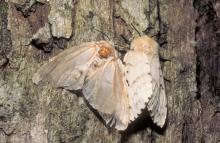
Species Types
Scientific Name
Lymantria dispar
Description
The spongy moth, introduced to our continent from Europe, has caused millions of dollars in damages to forests. Help protect our forests by learning how to recognize the spongy moth, and its larvae and egg masses, and report any occurrences you find.
Media

Species Types
Scientific Name
Harrisina americana
Description
Grapeleaf skeletonizer moths have all-black wings that they typically hold flat, away from the body. There is an unbroken collar of red or orange behind the black head.
Media
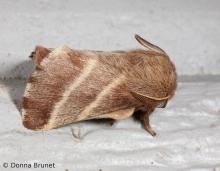
Species Types
Scientific Name
About 35 species in North America north of Mexico
Description
Tent caterpillar moths and lappet moths are medium-sized, with thick, long scales that make them look furry. The abdomen usually extends past the wings when they are folded back over the body.
Media

Species Types
Scientific Name
About 1,400 species in North America north of Mexico
Description
At rest, tortricid moths often have a distinctive shape, resembling an arrowhead or a bell, with the forewing tips either squared-off or flared outward.
Media
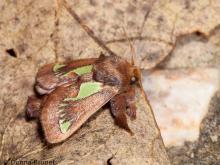
Species Types
Scientific Name
Euclea delphinii
Description
The spiny oak-slug moth is named for its caterpillar, which is armed with gaudy, stiff, stinging spines. If you touch them, the sting can feel something like a bee sting.
Media
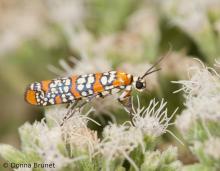
Species Types
Scientific Name
Atteva aurea
Description
Ailanthus webworm moths visit flowers in the daytime but also come to lights at night. Larvae live communally in silken webs in tree-of-heaven, an invasive tree from Asia.
Media

Species Types
Scientific Name
Malacosoma americana
Description
The silken tents of eastern tent caterpillars are conspicuous each spring in the forks of apple, cherry, and plum trees. The adult moths are brown with two pale stripes on the forewings.
Media
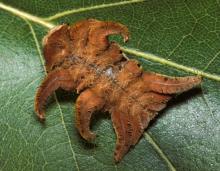
Species Types
Scientific Name
More than 20 species in Missouri
Description
Adult slug caterpillar moths are heavy-bodied and furry. The weird-looking caterpillars have suckers instead of prolegs, so they glide around like slugs. Don’t touch — many have stinging spines or hairs.
Media

Species Types
Scientific Name
About 25 species in North America north of Mexico
Description
Leaf skeletonizer moths are also called smoky moths because they have translucent smoky-brown, brownish gray, or black wings. Many species also have patches or orange or rusty color. Larvae eat all but the veins of leaves, leaving a skeleton of veins behind.
Media

Species Types
Scientific Name
Estigmene acrea
Description
The salt marsh moth, a type of tiger moth, is strikingly white with small black spots. Males have yellow-orange hindwings. The caterpillars are fast-moving woolly bears ranging from yellowish to brown to blackish.
See Also


Media

Species Types
Scientific Name
About 1,500 species in North America north of Mexico
Description
Adult caddisflies are mothlike. Their larvae are aquatic and build portable, protective cases out of local materials, including grains of sand, bits of leaves and twigs, and other debris.
Media

Species Types
Scientific Name
Corydalus cornutus
Description
Adult eastern dobsonflies are huge and mothlike, with large wings and a weak, fluttery flight. The fiercely predaceous aquatic larvae, called hellgrammites, are well-known to anglers, who often use them as bait.
About Butterflies and Moths in Missouri
Butterflies, skippers, and moths belong to an insect order called the Lepidoptera — the "scale-winged" insects. These living jewels have tiny, overlapping scales that cover their wings like shingles. The scales, whether muted or colorful, seem dusty if they rub off on your fingers. Many butterflies and moths are associated with particular types of food plants, which their caterpillars must eat in order to survive.





















